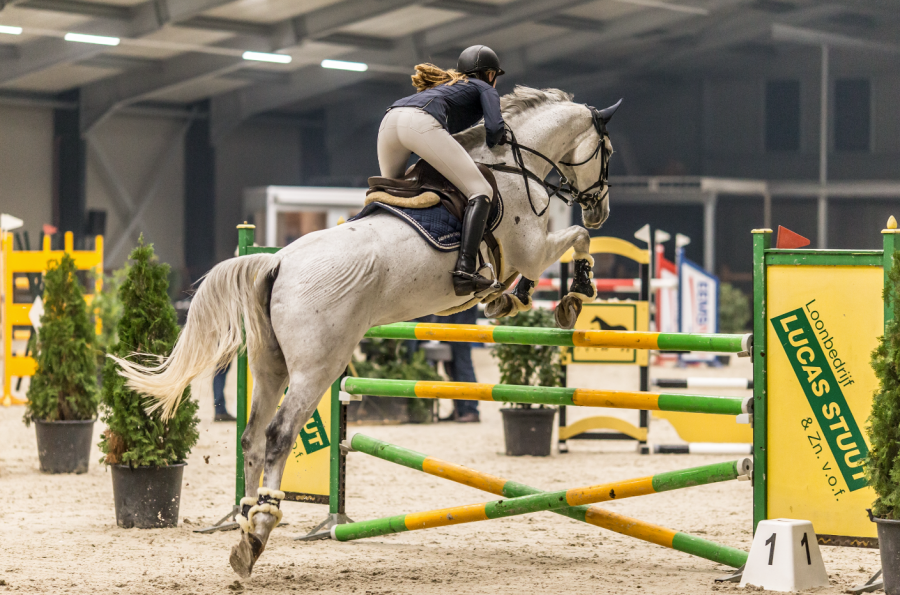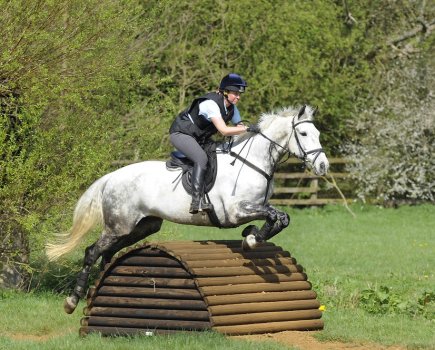Jumping indoors — whether you’re training or competing — can be a whole different ballgame, so it’s important that both you and your horse are prepared. It makes sense that the smaller the arena, the harder it becomes, particularly when you’re jumping. Competing indoors tends to be a seasonal thing — when the weather is calm and the going is good, most training and competitions (although not all) are done outside on grass. So for many riders and horses, when autumn hits and the weather turns, they find themselves jumping indoors for the first time in a long time.
“Jumping indoors for the first time in the year always affects horses – even the most experienced of them,” says British showjumping star Joe Stockdale, son of the late Olympian Tim Stockdale. “Going from big, light and spacious outdoor arenas into tighter indoor ones makes the fences look more closely packed. Horses seem more aware of the tight space, and I can tell that they feel restricted. It’s tough for the rider too – fences seem to come up much more quickly.”
Whether competing indoors or outdoors, Joe keeps the warm-up routine he uses for his horses the same.
“My warm up for both indoor and outdoor competitions doesn’t change too dramatically as I like to keep the routine the same for me and the horses,” he explains. “This allows for consistency in the way you prepare, and hopefully this will be reflected in your performance in the ring too. Each horse is different, of course, which should be reflected in the way you approach the warm up.”
Competing indoors: how to warm up
Remind yourself of the etiquette required for the warm up arena. There are two golden rules:
- Always pass left to left to prevent collisions and avoid circling in the immediate vicinity of the warm up fences so that you don’t block the take off or landing areas.
- Don’t chase the horse in front of you to the warm up fence, leave plenty of room between your horse and theirs so that if they knock it down you don’t have to take evasive action to avoid the fence, which isn’t great preparation for your horse’s jumping round.
“I keep an eye on what’s going on around me and start the jumping phase of my warm up when there are about eight horses to go until it’s me,” says Joe. “It doesn’t help to over-jump a horse. Remember the warm up is just that – a warm up.
“I start by jumping a small vertical and build it up to about the height I’m going to jump in the ring. There’s really no need to jump anything bigger than what you’re about to face. After I’ve jumped the vertical, I tackle the oxer, raising it two or three holes at a time until I get to the height I’ll be jumping in the ring.”
Competing indoors: getting it right in the ring
When jumping indoors in an arena that feels small and ‘busy’, your horse will need to be super attentive to your aids, but also be prepared to think for themselves when needed. They also need to be super balanced to deal with all the tight turns involved. Here are eight tips to prepare you both for a confident round:
1 Create confidence
As Joe says above, the first thing to nail is your warm up. Create a simple that you can use at home before a jumping session and then replicate it at competitions. It should involve lots of circles, changes of bend and transitions. Make sure your horse stretches at the beginning and end of the warm up too.The familiarity of your warm-up routine will give you and your horse confidence.
2 Shorten your distances
When competing indoors over fences you’ll be faced with shorter related distances — three- or four-stride combinations rather than seven or eight. Build these distances at home to help your horse deal with them.
3 Practise in tight spaces
Space will be tighter when competing indoors and you’ll be jumping ‘into’ the wall. You can practise this in your field or outdoor school at home — just position the jumps near the edge of the arena or fence line and closer together than usual. This will help you both hone your skills at jumping on and off tight turns, as well as short lines to the approach of a fence and its exit. Advanced event rider Barry Meningen shares three simple but effective exercises to try when training here.
4 Hire an indoor arena
Most people don’t have their own indoor school (we wish), but it’s a good idea to practise in one if you can by hiring a school for an hour so that you (and your horse) can get a feel for it. Many indoor jumping venues leave the course up the day after a competition so that people can hire it for training sessions. Make the most of these opportunities when they come up.
5 Make the most of every corner
Use all the corners when you’re competing indoors, because there will be less room to take a turn and so you must utilise the space that’s available well. Cutting corners wastes precious space that could mean the difference between a good stride and a poor one, and a clear round or jumping penalties.
6 Walk the course well
Walk the course carefully and watch a number of other competitors’ rounds before you’re called in to jump. This way you can work out what’s causing riders most problems and where there are any particularly tight turns and lines — perhaps some that you didn’t notice on your course walk.
7 Beware shadows when competing indoors
Shadows occur outside on sunny days too, of course, but when you’re jumping indoors the way the lights shine on some fillers may be spooky and dark corners could cause a spook too. Indoor arenas can be noisy too, with the sound of voices, footsteps, coffee cups, chairs etcetera echoing around the ring. Those sounds will feel close to you too, and it can take some getting used to.
8 Relax and have fun
Remember, you’re competing indoors to enjoy yourself and make memories with your horse — and a rosette would be the icing on the cake! Take a few deep breathes and think positively. If you’re feeling nervous, there are things you can do to help you feel more confident.
Main image credit: Shutterstock for illustration purposes only. Joe Stockdale is not pictured.
Love hacking? Join our free #Hack1000Miles challenge and see how far you can go!
Subscribe to Your Horse Magazine – the perfect Christmas gift!










